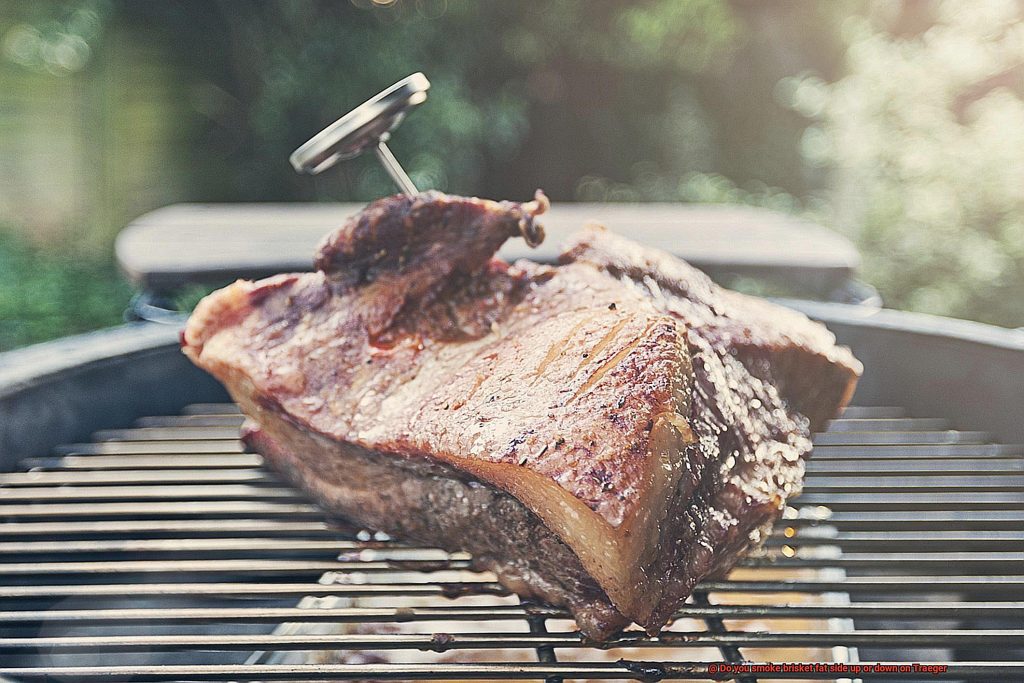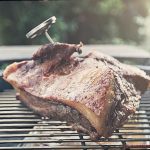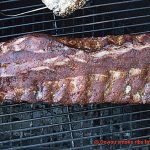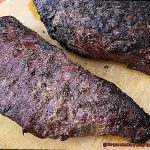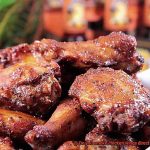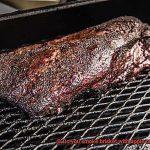Today, we tackle a burning question that’s got grilling gurus fired up: should you slap that brisket fat side up or down on your trusty Traeger smoker? This simple query has sparked fiery debates among BBQ fanatics for years.
But fear not, fellow grillers. We’re here to sizzle up the truth and settle this age-old culinary conundrum.
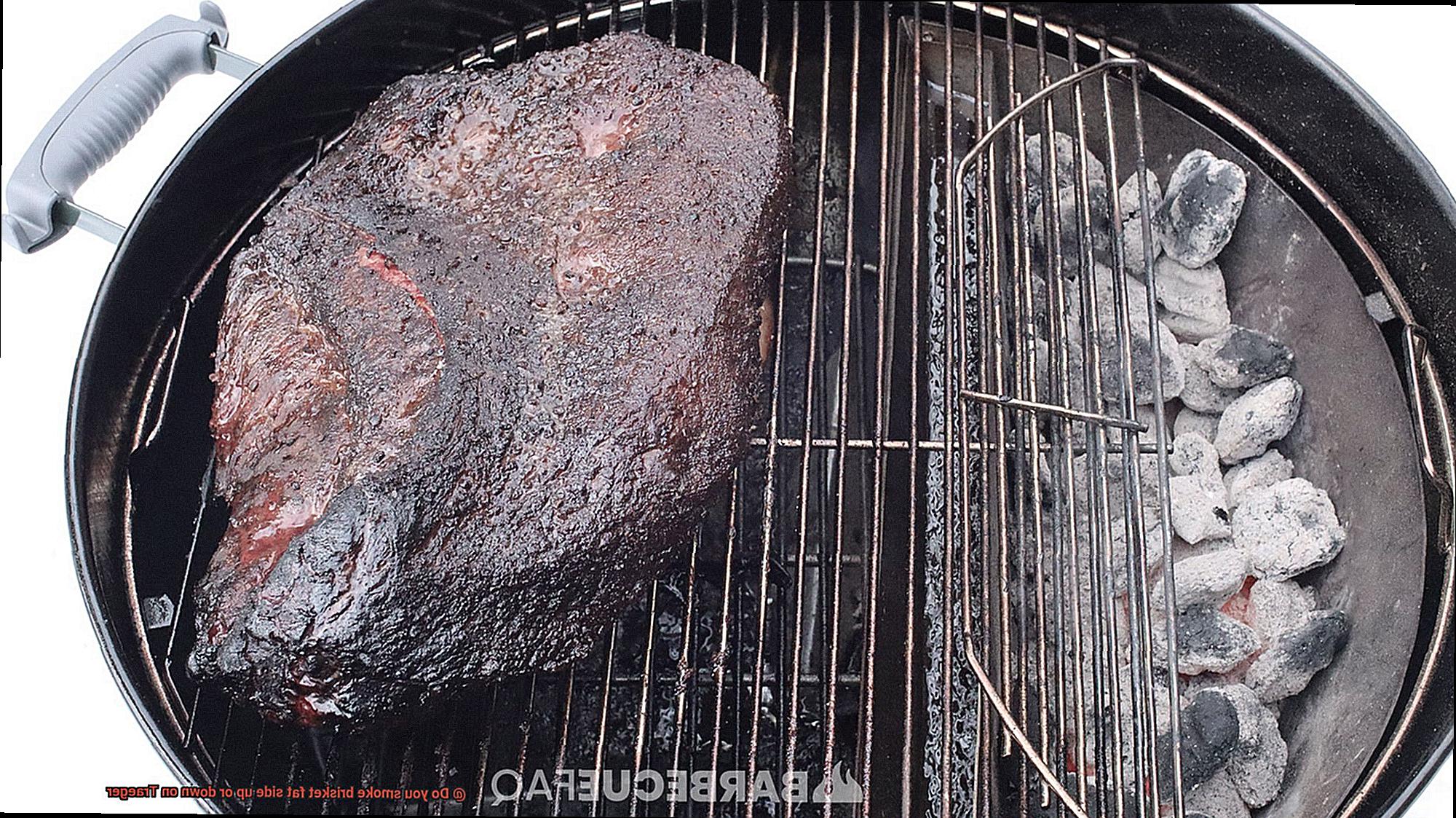
So grab a cold one, kick back, and let’s dig into the juicy details of smoking brisket on a Traeger.
Contents [show]
What is a Traeger Grill?
A Traeger Grill is not your ordinary grill. It’s a culinary masterpiece that combines traditional grilling methods with cutting-edge technology, revolutionizing the way we cook outdoors. So, what sets a Traeger Grill apart from the rest?
First and foremost, a Traeger Grill uses wood pellets as its fuel source. These pellets, made from compressed sawdust, come in a variety of flavors like hickory, mesquite, and applewood. The wood pellets are loaded into a hopper, which then feeds them into an auger.
This ingenious mechanism transports the pellets to a combustion chamber, where they are ignited, producing heat and smoke that infuse your food with incredible flavor.
But the magic doesn’t stop there. A Traeger Grill offers versatility like no other. It can grill, smoke, roast, bake, and even braise your favorite dishes. Whether you’re in the mood for juicy steaks or succulent smoked ribs, the precise temperature control system ensures that your food cooks to perfection every time. Want to experiment with different cooking styles? No problem. A Traeger Grill gives you the freedom to unleash your creativity in the kitchen.
Ease of use is another hallmark of a Traeger Grill. With digital controllers and easy temperature adjustments, you’ll feel like a master chef in no time. Some models even have Wi-Fi connectivity, allowing you to control and monitor your grill remotely through an app on your smartphone. So sit back, relax, and let technology do the work while you enjoy the company of family and friends.
Durability is also a key feature of Traeger grills. Constructed with high-quality materials that can withstand any weather conditions, these grills are built to last. Plus, many models come with convenient features like side shelves for prep space, storage areas for grilling tools, and wheels for easy portability.
The Debate of Smoking Brisket Fat Side Up or Down
It’s a battle between two teams, each with their own arguments and beliefs. On one side, we have the fat side up crew. These folks believe that placing the brisket fat side up allows the fat to render down and baste the meat as it cooks. It’s like giving your brisket a luxurious spa treatment, keeping it moist and flavorful throughout the smoking process. And that fat acts as a natural barrier, protecting the meat from drying out and adding a rich, melt-in-your-mouth goodness to the final product.
But wait, because the fat side down team has something to say too. They argue that placing the brisket fat side down allows for better bark formation. That fat acts as a brave shield, shielding the meat from direct heat exposure and allowing it to develop a deep, flavorful crust. Who doesn’t love a juicy, flavorful bark on their smoked brisket? It’s like biting into BBQ perfection.
Heat distribution is another factor to consider. Some smokers have hot spots that can wreak havoc on your brisket. Placing the fat side down can help protect your meat from excessive heat exposure and potential burning. This method ensures more even cooking and prevents any areas of your brisket from becoming overcooked or dried out.
Ultimately, whether you choose to go fat side up or down on your Traeger (or any other smoker) comes down to personal preference and experimentation. We recommend trying both methods to see which one brings out the best flavors, textures, and overall BBQ experience for you.
But don’t forget about proper trimming and seasoning. No matter which method you choose, it’s essential to trim excess fat and apply a flavorful rub to enhance the taste of your brisket. These steps are key in creating a mouthwatering masterpiece, regardless of the smoking method.
Pros and Cons of Smoking Brisket Fat Side Up
Prepare to enter the sizzling world of brisket smoking, where the age-old debate of smoking brisket fat side up or down rages on. In this article, we will explore the pros and cons of smoking brisket fat side up, guiding you through the smoky journey of flavor and texture. So don your apron, fire up your smoker, and let’s settle the fat side up controversy once and for all.
Advantages of Smoking Brisket Fat Side Up:
- Moisture Retention: The layer of fat on top acts as a natural moisture barrier, preventing the meat from drying out during the smoking process. This results in a juicy and tender brisket that will leave your taste buds dancing with joy.
- Basting and Flavor Infusion: As the fat renders down, it bastes the meat, infusing it with rich flavors. This enhances the overall taste profile of the brisket, adding a touch of decadence to each mouthwatering bite.
- Beautiful Presentation: Smoking brisket fat side up creates an aesthetically pleasing presentation. The rendered fat caramelizes on top, forming a tantalizing crust that will make your guests’ mouths water before they even take a bite.
- Even Heat Distribution: The layer of fat acts as an insulator, ensuring that heat is distributed evenly throughout the brisket. This prevents hot spots and guarantees a perfectly cooked brisket every time.
Disadvantages of Smoking Brisket Fat Side Up:
- Reduced Smoke Penetration: Some pitmasters argue that smoking brisket fat side up can hinder smoke penetration into the meat, resulting in less intense smoky flavor. For those who crave that signature smokiness, this may be a downside.
- Potential Bark Challenges: The fat layer on top can create a barrier between the meat and the heat source, making it more difficult to achieve a crispy bark on the bottom of the brisket. If you’re a fan of that satisfying crunch, this could be a drawback.
- Longer Rendering Time: The fat on top takes longer to render down compared to if it were on the bottom. This means that it may take more time for the fat to fully melt and distribute its flavors throughout the meat, potentially lengthening the cooking process.
Pros and Cons of Smoking Brisket Fat Side Down
Today, we’re settling the age-old debate of whether to smoke brisket fat side up or down. So, grab your aprons and get ready for a flavorful journey.
Let’s start with the pros of smoking brisket fat side down. First and foremost, it provides heat protection. The layer of fat acts as a barrier between the meat and the heat source, ensuring a more even and gentle cooking process. This prevents the brisket from drying out or becoming overcooked.
Next up is moisture retention. As the fat renders and melts, it drips down onto the meat, keeping it moist and bursting with flavor. This natural basting process results in a juicier end product with a succulent texture that will leave your taste buds dancing.
And let’s not forget about the flavor. Smoking brisket fat side down allows the rendered fat to infuse into the meat, creating a depth of flavor that is simply mouthwatering. The fat carries with it the smoky essence from the wood pellets or chips, enhancing the overall taste profile of the brisket.
Now, let’s talk about the cons. One downside is that smoking fat side down may inhibit bark development. The fat layer can act as a barrier, preventing the formation of a thick and crispy bark that many barbecue enthusiasts crave.
Another concern is heat distribution. Smoking fat side down can lead to uneven heat distribution on the meat’s surface, resulting in inconsistencies in tenderness and doneness throughout the brisket.
Lastly, some argue that smoking fat side down may limit smoke penetration into the meat. They believe that positioning the fat side up allows for better absorption of smoky flavors into the exposed meat surface.
Other Factors to Consider When Smoking a Brisket on a Traeger Grill
When it comes to smoking a brisket on a Traeger grill, there are several factors to consider that go beyond the age-old debate of fat side up or down. Achieving the perfect tender and flavorful brisket requires attention to temperature control, smoke flavor, bark formation, moisture retention, and understanding the unique design of a Traeger grill.
Temperature control is crucial for smoking brisket. Traeger grills are known for their precise temperature control, allowing you to maintain a consistent temperature throughout the cooking process. For a mouthwatering brisket, it is recommended to smoke it low and slow at around 225-250°F. This slow cooking allows the flavors to develop and ensures a juicy end result.
Smoke flavor is another consideration. The position of the fat cap can affect the level of smoke penetration. Smoking with the fat side up creates a barrier, resulting in a milder smoky flavor. On the other hand, smoking with the fat side down allows the smoke to directly penetrate the meat, giving you a more pronounced smoky taste. The choice ultimately depends on your personal preference for smoke intensity.
Now let’s talk about bark formation. The bark, that delicious outer crust on a smoked brisket, is highly sought after. Smoking with the fat side up is recommended if you desire a well-developed and flavorful crust. The fat acts as a protective layer, ensuring even browning of the bark. However, if you prefer a slightly crisper bark, smoking with the fat side down exposes the meat directly to heat, resulting in a slightly different texture.
Moisture retention is an essential factor to consider. The fat cap on a brisket acts as a natural barrier that helps retain moisture during cooking. Smoking with the fat side up allows the fat to slowly render and baste the meat, keeping it moist and preventing it from drying out. If moisture retention is important to you, then smoking with the fat side up is the way to go.
Lastly, let’s not forget about Traeger grill’s design. These grills utilize a convection-style cooking method, where hot air circulates evenly around the meat. This even heat distribution helps ensure consistent cooking and can contribute to a moist and tender brisket, regardless of the position of the fat cap.
Tips for Achieving Tender and Juicy Brisket on a Traeger Grill
Smoking brisket on a Traeger grill can be a mouthwatering experience, but achieving a tender and juicy result requires careful technique. In this post, we’ll explore the steps to ensure your brisket is cooked to perfection on a Traeger grill.
Start with a high-quality brisket:
Selecting the right cut of brisket is essential for achieving tender and juicy results. Look for a well-marbled brisket with a good fat cap. The marbling will keep the meat moist and tender during the cooking process, while the fat cap provides additional flavor.
Trim excess fat:
While some fat is necessary for flavor and moisture, trimming excessive fat is crucial. Too much fat can prevent proper smoke penetration and result in a greasy finished product. Trim the fat down to about ¼ inch thickness, leaving a thin layer to protect the meat during cooking.
Season generously:
To enhance the flavor of your brisket, generously season it with your favorite dry rub or marinade. Apply the seasoning evenly on all sides of the brisket, allowing it to infuse into the meat as it cooks.
Preheat and stabilize your Traeger grill:
Before placing the brisket on the grill, preheat it to a temperature of around 225°F. This allows for even cooking and helps develop a beautiful smoke flavor. Stabilize the temperature before adding the meat to ensure consistent results throughout the cooking process.
Place the brisket fat side up:
Contrary to popular belief, it’s recommended to smoke brisket with the fat side up on a Traeger grill. The fat acts as a natural basting agent as it renders down during cooking, keeping the meat moist and preventing it from drying out. Additionally, when the fat side is up, it acts as insulation, protecting the meat from direct heat exposure.
Monitor internal temperature:
Use a reliable meat thermometer to monitor the internal temperature of your brisket throughout the cooking process. Brisket is typically cooked low and slow, and the internal temperature should reach around 195-205°F for optimal tenderness. This ensures that the collagen in the meat has broken down, resulting in a tender and juicy finished product.
Wrap in foil or butcher paper:
Once the brisket reaches an internal temperature of around 160-165°F, you can choose to wrap it in foil or butcher paper. This technique, known as the Texas crutch, helps accelerate the cooking process and prevents the meat from drying out. Wrapping also helps retain moisture and enhances tenderness.
7V836gYyVRo” >
Conclusion
In conclusion, the age-old debate of whether to smoke brisket fat side up or down on your trusty Traeger grill has ignited passionate discussions among BBQ aficionados for years. Each method boasts its own merits and drawbacks, leaving the final decision in the hands of personal preference and adventurous experimentation.
Opting to smoke your brisket fat side up on a Traeger grill presents a multitude of advantages. The layer of luscious fat acts as a natural shield against moisture loss, ensuring that every succulent bite remains tender throughout the smoking process. As the fat gradually melts away, it lavishes the meat with its delectable essence, infusing each fiber with an irresistible richness. Moreover, this technique guarantees even heat distribution and safeguards against any potential scorching mishaps.
However, those who dare to venture down the path of smoking brisket fat side down can revel in their own set of rewards. By positioning the fatty side facing downward, a protective barrier is formed against direct exposure to intense heat. This fortification nurtures the development of an impeccable bark – that coveted layer of caramelized goodness – while allowing for deeper smoke penetration and an intensified smoky flavor profile. Nevertheless, achieving a crispy bark on the underside may pose a delightful challenge.
When embarking on your smoky escapades with your beloved Traeger grill, it’s crucial to consider additional factors such as temperature mastery, smoke infusion finesse, bark formation finesse, moisture retention mastery, and an intimate understanding of your grill’s unique design. Adhering to proper trimming and seasoning techniques serves as the cornerstone for crafting a tantalizing masterpiece regardless of your chosen smoking approach.
By embracing these invaluable tips and techniques with open arms, you will undoubtedly conjure forth tender and juicy brisket from your mighty Traeger grill that will leave both family and friends awe-struck at your next BBQ gathering.

